To fix a baggy crotch in your jeans without sewing, turn them inside out and lay them flat. Cut a rectangular patch from scrap denim to cover the area, and place cardboard inside to prevent glue seepage. Apply fabric glue to the patch, press firmly, and let it dry for about 20 minutes. Once dry, turn the jeans right side out, check the repair, and use a felt marker for any visible glue. You'll discover more tips to maintain your jeans as you keep going.
Key Takeaways
- Turn jeans inside out and lay them flat to ensure a clean repair process.
- Cut a rectangular patch from excess denim to cover the baggy crotch area effectively.
- Use Speedo fabric glue for a no-sew solution, applying it evenly on the patch.
- Insert cardboard inside the jeans to prevent glue from seeping through during application.
- After drying, turn jeans right side out and use a felt marker to conceal any visible glue residue.
Materials Needed for Repairing Jeans
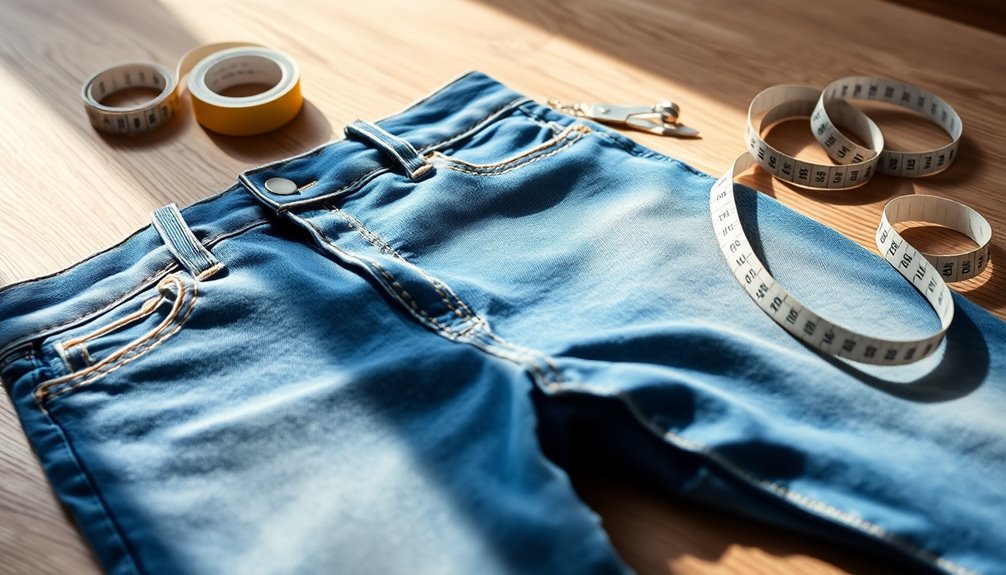
To tackle the issue of a baggy crotch in your jeans, you’ll need a few essential materials. First, grab a pair of jeans that need fixing, along with Speedo fabric glue for a no-sew solution. You may also want to have a pair of scissors on hand to trim any excess fabric. Start by determining how much fabric you need to remove from the crotch area, then apply the Speedo fabric glue carefully. This quick guide will explain how to adjust baggy crotch pants, ensuring a more tailored fit and improved comfort.
You'll also want some scrap material from excess jean fabric to reinforce the area. Don't forget a piece of cardboard to insert inside the jeans; this prevents glue from seeping through during the repair process.
A felt marker can help cover any visible glue residue once you're done, giving your jeans a neater appearance. Finally, make sure your workspace is clean and organized, as this will make the repair process more efficient.
Allow the fabric glue to dry for about 20 minutes for a durable fix.
Preparing Your Jeans for Repair
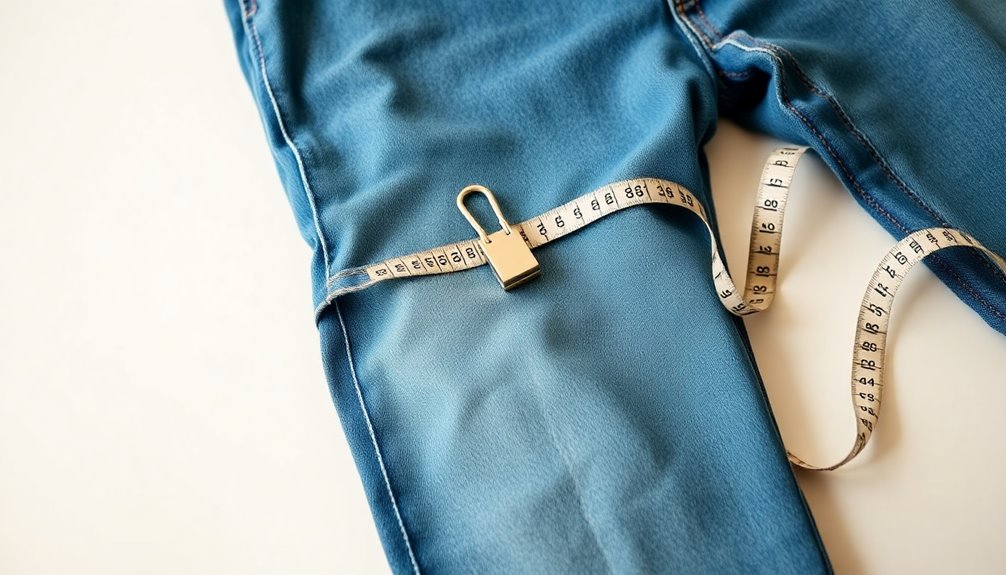
Preparing your jeans for repair is an essential step in achieving a seamless fix for that baggy crotch.
Start by turning your jeans inside out to keep the repair hidden when you wear them. Lay the jeans flat on a clean, organized surface to guarantee stability and easy access to the area needing attention.
Next, cut a rectangle from scrap denim that adequately covers the baggy crotch area for effective reinforcement. To protect the outer layer, insert a piece of cardboard inside the jeans, preventing any glue from seeping through.
Finally, make certain your workspace is free from clutter to facilitate a smooth and efficient repair process.
This preparation will set you up for a successful and discreet fix!
Cutting and Positioning the Patch
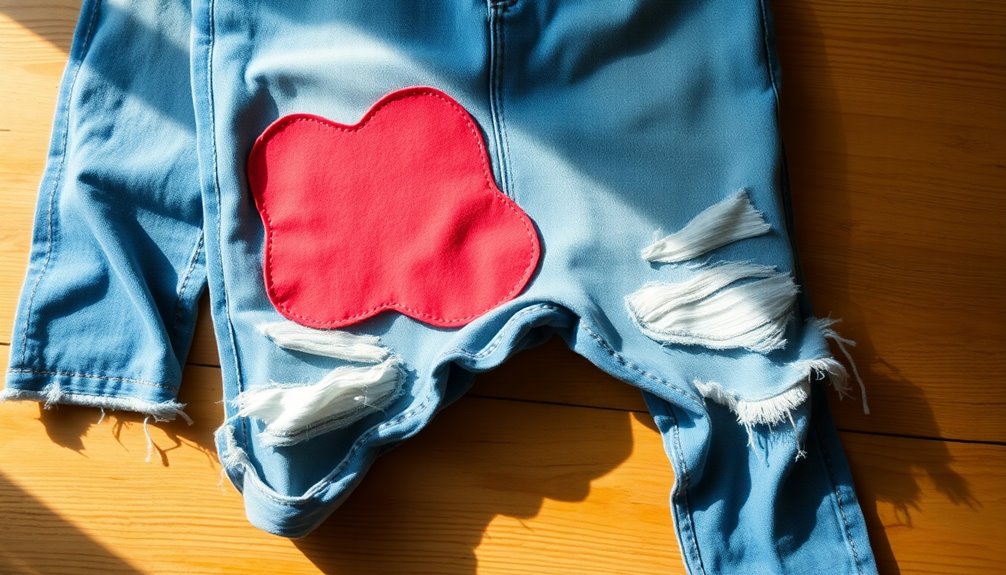
With your jeans turned inside out and laid flat, it's time to cut and position the patch. Start by cutting a rectangular patch from excess jean material, ensuring it's large enough to cover the baggy area and extends beyond the edges needing support.
Next, position the patch over the baggy crotch area, aligning it with the seam and contours of the jeans for a seamless look.
- Feel the texture of the denim as you place it.
- Visualize the patch blending in perfectly with the fabric.
- Imagine the snug fit you'll achieve once it's secured.
Don't forget to insert a piece of cardboard inside the jeans to prevent glue from seeping through. This step is essential for a clean finish!
Applying Fabric Glue Effectively
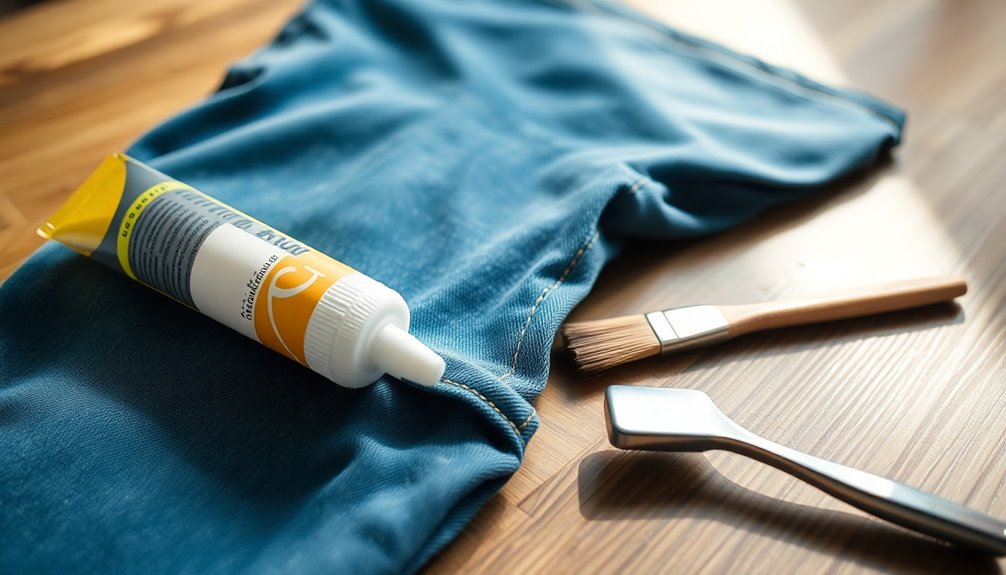
Before applying fabric glue, make sure your jeans are inside out and laid flat for an even and mess-free application.
Cut a piece of scrap material that covers the baggy area adequately, ensuring it's large enough for support.
Squeeze a generous amount of Speedo fabric glue onto the scrap material and spread it evenly for complete coverage.
Once you've positioned the patch over the baggy area, apply firm pressure to secure it in place and prevent any movement. This will help the glue bond effectively.
Allow the glue to dry for about 20 minutes, keeping the patch undisturbed for a strong, durable repair before turning your jeans back to their right side.
Monitoring the Drying Process

As you monitor the drying process, check the patch every five minutes to confirm it stays undisturbed and adheres properly.
Avoid exposing your jeans to direct sunlight or heat sources, which could compromise the glue's integrity. The glue usually takes about 20 minutes to dry, but if it's humid, give it extra time.
Occasionally, gently press down on the patch to guarantee a secure bond between the scrap material and your jeans.
- The soft texture of the fabric beneath your fingers
- The faint smell of glue slowly fading away
- The anticipation of a snug fit as you wait
After drying, inspect the patch for any signs of lifting before turning the jeans back to the right side.
Finalizing the Repair

Once the glue has dried, it's time to turn your jeans right side out and check the repair. Gently tug the patched area to verify it holds securely without lifting. If you notice any visible glue residue, use a felt marker to cover it for a cleaner look.
| Action | Purpose |
|---|---|
| Tug at the patch | Test the repair's stability |
| Use felt marker | Conceal any glue residue |
| Store carefully | Protect the patched area |
| Inspect other areas | Identify additional repairs needed |
Tips for Maintaining Your Jeans
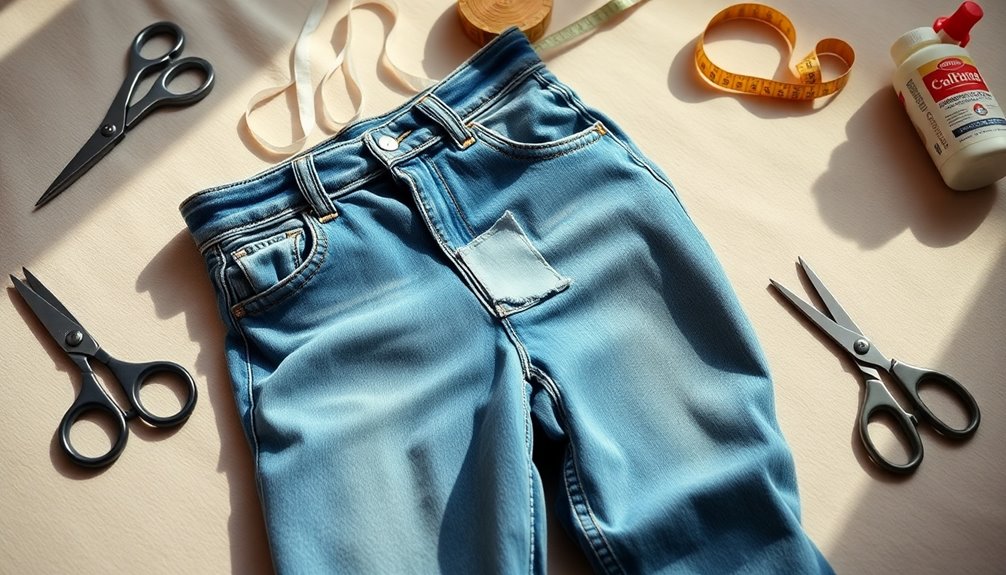
To keep your jeans looking their best, start with proper washing techniques and storage practices.
Regular inspections can also help you catch any issues before they become bigger problems.
Proper Washing Techniques
When you're looking to maintain your jeans and prevent issues like a baggy crotch, proper washing techniques play an essential role.
Start by washing your jeans inside out to keep their color vibrant and protect any embellishments. Always use cold water to prevent shrinkage and maintain the fabric's integrity.
- Opt for a gentle cycle to minimize agitation, ensuring your jeans stay in shape.
- Skip the fabric softeners, as they can weaken denim fibers over time.
- Whenever possible, air dry your jeans to avoid the damaging heat of the dryer. Additionally, regular home cleaning can help you maintain not just your jeans but your entire wardrobe in great condition by reducing dust and allergens.
Storage Best Practices
While you might think the way you store your jeans doesn't matter, it can greatly impact their longevity and fit.
Always fold your jeans instead of hanging them; this prevents distortion and helps maintain their shape over time. Store them in a cool, dry place, away from direct sunlight to avoid fading and material deterioration.
Using drawer organizers or bins keeps your jeans separate from other clothes, reducing friction and wear.
Remember to wash your jeans inside out on a gentle cycle, and avoid frequent washing to extend their lifespan. For extra protection, consider adding cedar blocks or lavender sachets in your storage area to deter moths and keep your jeans smelling fresh. Additionally, consistent maintenance of your jeans can prevent wear and tear that may affect their fit and appearance over time.
Regular Inspections Needed
Proper storage keeps your jeans looking great, but regular inspections are key to maintaining their fit and longevity. Make it a habit to check your jeans regularly for any wear and tear. This simple practice can save your favorite pairs from becoming baggy and unflattering.
- Look closely at seams and the crotch area for signs of wear that might worsen over time.
- Inspect for fading or stretching that impacts fit and appearance.
- Check for loose threads or fraying edges, indicating it might be time for repairs.
Also, assess comfort and fit periodically, as your body shape can change. Keeping an eye on these details guarantees your jeans stay looking fresh and fitting perfectly!
Frequently Asked Questions
How to Fix a Baggy Crotch on Jeans?
If you've got a baggy crotch in your jeans, don't worry! You can easily fix it without sewing.
First, find some fabric glue and a scrap piece of jean material. Cut the scrap to size, then turn your jeans inside out.
Apply the glue to the scrap and press it onto the baggy area. Let it dry for about 20 minutes, then check for fit and comfort.
Adjust as needed, and you're good to go!
How Do You Make Baggy Jeans Tighter Without Sewing?
Ever wonder how to make those baggy jeans fit better without a needle and thread? You can easily tighten them using fabric glue to attach a scrap piece of material inside the waistband.
Fold the excess fabric at the crotch and apply some Speedo fabric glue for a snugger fit. You could also loop elastic bands through the belt loops or use safety pins to cinch the fabric.
A good belt can help too!
How to Fix Stretched Out Crotch in Jeans?
To fix a stretched-out crotch in your jeans, start by turning them inside out.
Cut a scrap piece of denim into a rectangle that covers the baggy area.
Insert cardboard inside the jeans to catch any glue.
Apply Speedo fabric glue generously on the patch, press it firmly onto the affected area, and let it dry for about 20 minutes.
Once dry, check the repair for stability and appearance before wearing them again.
How to Fix a Hole in Jeans Crotch Without Sewing?
If you've got a hole in the crotch of your jeans and you don't want to sew, here's a simple fix.
First, turn the jeans inside out and grab some scrap fabric. Cut it to size and use fabric glue to attach it over the hole.
Don't forget to place cardboard inside to keep the glue from seeping through. Let it dry for about 20 minutes, and you're good to go!
Conclusion
With a little creativity and some fabric glue, you've transformed your baggy jeans from drab to fab! Like a tailor's magic wand, these simple steps have turned a frustrating fit into a snug embrace. As you slip into your newly repaired jeans, remember to cherish their journey—each patch tells a story of resourcefulness and style. So strut your stuff with confidence, and let your jeans shine as a symbol of your DIY prowess!









